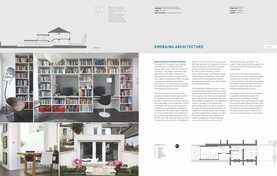We aim to undertake the full range of design, procurement and construction stages, to guide our clients through all the stages from concept to completion, from dreams to keys, or alternatively individual stages to suit your specific requirements and budget.
The process of making a building is organized into a number of key stages, below is a brief overview of these work stages.
The process of making a building is organized into a number of key stages, below is a brief overview of these work stages.
|
WORK STAGE 1: INITIAL DESIGN
The architect’s work begins with an analysis of your requirements. S/he will relate your needs and quality standards to your budget. The success of your project depends in large measure on the quality of your brief- your description to your architect of what you need from the building. This information enables your architect to develop a design related to your needs and wishes. Agreeing a realistic budget for your project is an important part of Work Stage 1. It maybe that your needs cannot be met within the available budget or market conditions may make achieving your budget difficult. If your budget is fixed you should make this clear to your architect at the start. If you require a particular standard of kitchen or other fittings and finishes you should discuss this with your architect. If, because of these or other similar factors, a cost cannot be established at this stage your architect will use the RIAI Cost Guidelines to arrive at an initial estimate of building cost. |
|
WORK STAGE 2: DEVELOPED DESIGN
The architect will analyse your requirements further and will present developed proposals in the form of drawings for you to evaluate. Drawings can be difficult to understand, but it is vital that you work with your architect to fully understand the proposals, before applying for any planning permission and before starting to build. If you have any doubts, raise them with your architect at the time so that you fully understand and agree about what is to be built. This is important, because once a project goes on site, changes can be expensive, can delay the project, and may even require an additional planning permission. Project cost and timescale should be re-evaluated and agreed at this stage |
|
WORK STAGE 3: DETAIL DESIGN
Having translated your brief into a developed design, your architect will produce detailed drawings and specifications for competitive pricing by builders. The architect will prepare a list of suitable contractors with you. Contractors should be preselected on the basis of quality, and in general the lowest tenderer will be awarded the contract. A good contractor represents real value in terms of reliability and quality, and will ultimately cost less than a poor one, no matter how cheap a price the latter might have submitted. The builder or ‘contractor’ enters into a contract with you, to carry out the building work. In turn, the contractor has contracts with specialist sub-contractors and with suppliers of materials. The RIAI Code of Professional Conduct states that your RIAI independent consulting architect will have no financial interest in any building contracting firm and receives no commissions or discounts from contractors or suppliers, so you can be sure that the advice you get is free of any conflict of interest. |
|
WORK STAGE 4: CONSTRUCTION
The architect will help you evaluate the tenders received, and, when construction starts, ad as your independent advisor during building work, liaising with the builder but independent of him, and inspecting the work at intervals on your behalf to ensure that it is being carried out generally in accordance with the contract documents. Your architect will advise you on stage payments during the project, and will not certify payments unless the work complies with the specifications. During construction, it is best that you do not give instructions directly to the contractor, because what can seem a simple change may have cost and time implications not easily foreseen. If you think you do need to make changes, discuss these with your architect to make sure that they are necessary and so that any additional cost can be established and controlled. Remember that the architect is not the builder, and does not supervise the work-that is the builder’s job. Remember, too, that the architect’s provision of Opinions on Compliance with Planning and Building Regulations is subject to the work not being changed during construction. During the construction stage the architect administers the building contract as your agent but s/he is legally required to act fairly between you and the builders. Remember that the builder is in business to make a profit. Your relationship with the builder should be on a business basis. The architect’s work continues after the building work is finished, as part of the payment due to the builder is held back for up to twelve months and is only paid out, on the architect’s instruction, after any defects have been rectified by the contractor. |



